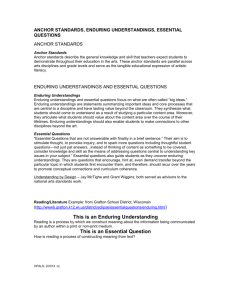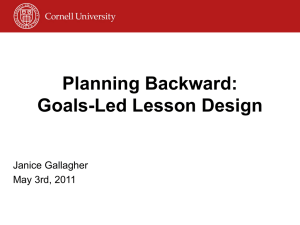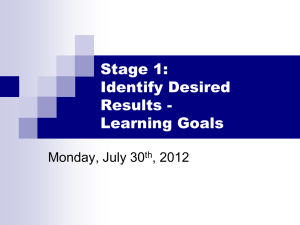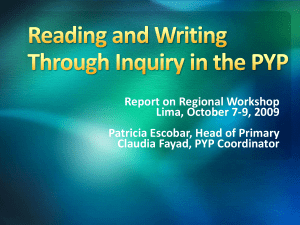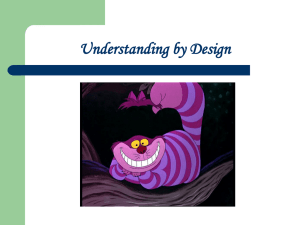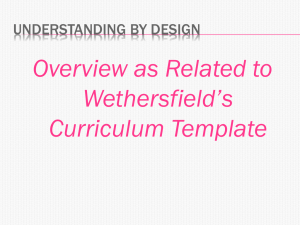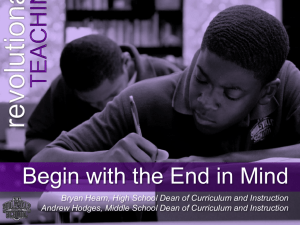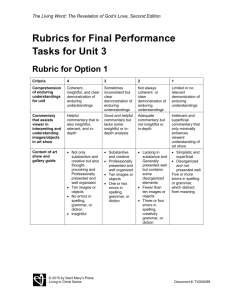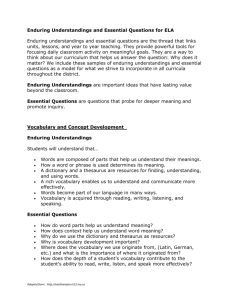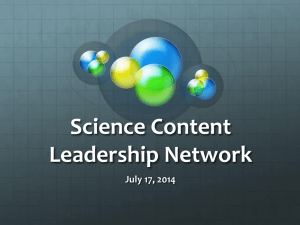Understanding by design: Lower School
advertisement
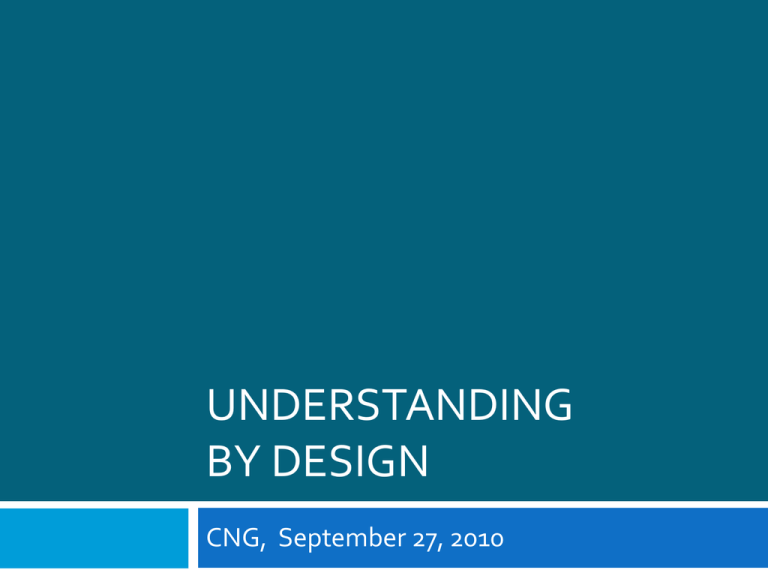
UNDERSTANDING BY DESIGN CNG, September 27, 2010 Goals / Objectives Introduce and discuss the 3 stages of Understanding by Design (also known as Backward Design because you begin with the end in mind) Practice creating Enduring Understandings and Essential Questions Activating Prior Knowledge In your groups, please generate a list in two minutes or less that encapsulates what you know about the topic you are given Differentiation of Instruction Content—What you teach Process—How you teach it Product—How you assess what you taught Student Interest Student Readiness Student Interest Assessment FOR Learning Balanced approach to assessment Formative—ongoing with consistent, specific feedback; informs future teaching Summative—culminating with specific feedback and guidance for future learning Using a variety of assessment practices Performance Assessments Authentic experiences that require application of learning in meaningful ways for a particular audience CNG Assessment Beliefs Assessment takes a variety of forms including self assessment, informal observation, projects, performance tasks and portfolios, oral responses and reports, short constructed responses, essays, forced choice items, amongst others. Teachers should inform students in advance of content, concepts and skills that will be addressed in assessments. CNG Assessment Beliefs The type of test/assessment used to assess learning should be developmentally appropriate and determined by the nature of the learning outcomes and the types of learners being assessed. In order to maximize learning, feedback on assessments is both specific and timely. CNG Assessment Beliefs It is invaluable for educators to collaboratively reflect on students’ work/learning in order to reflect upon instructional decisions and practices. Assessment is inseparably linked to instruction. Everything that is assessed is taught and is in the curriculum. Effective assessment improves student learning, and the more we know about our students, the better teachers we become. New Information Understanding by Design: Backward Design Process Stage One: Identifying Desired Results Enduring Understandings Essential Questions Standards and Benchmarks Stage Two: Determining Acceptable Evidence of Learning Assessment-Formative and Summative Valid, reliable, sufficient, and feasible Stage Three: Planning Learning Experiences and Instruction Activities Resources Understanding by Design: Connection to Differentiation of Instruction Stage One: Content (and Skills)—What we teach Stage Two: Product (Assessment)—How we know students have learned what we’ve taught Stage Three: Process—How we teach…instructional strategies and grouping Applying New Information Unit Plans and UbD Consider a unit/theme that you will do this year and identifying the Stages: One (Desired Results), Two (Acceptable Evidence) and Three (Instructional Plan). Is anything missing? If so, what? How might you address or augment? Stage One Identifying Desired Results Enduring Understandings What do you think this means? Spend a minute thinking independently or talking with a neighbor. Jot down your ideas… Enduring Understandings Jay McTighe: Think about the words “enduring understanding.” Enduring: What do you want to last and why? Five years from now after the kids forget all the details, after the quiz or the test, what do you hope they will still understand? Eight years from now, what do you want them to be able to do with knowledge and skills that you have taught? That is the idea of enduring. Enduring Understandings Transferable big ideas Phrased as declarative sentences Designed to promote student connections, insights, and applications Specific enough to guide teaching and assessing Framed by provocative Essential and Unit Questions Students will understand that… Sample Enduring Understandings Scientific knowledge develops through carefully controlled investigations Authors do not always say exactly what they mean and mean exactly what they say Great artists often break with established traditions, conventions and techniques to better express what they see and feel A president is not above the law Applying New Information Enduring Understandings Your Turn…Consider a unit and develop a few 1. 2. 3. 4. Represent enduring and transferable big ideas that have value beyond the classroom. Express big ideas and core processes at the heart of a discipline or content area. Help unpack abstract, counterintuitive, often or easily misunderstood ideas requiring uncoverage. Help reveal the big ideas embedded in facts, skills, and activities. Essential Questions What do you think this means? Spend a minute thinking independently or talking with a neighbor. Jot down your ideas… Essential Questions Jay McTighe: We like to frame big ideas around essential questions. An essential question is a question that serves as a doorway for exploring a big idea, for uncovering the content. And, therefore, a good essential question typically doesn’t have a single correct answer, [and] is a question that is debated and discussed in the field today, a question that can be fruitfully revisited again and again. And as we revisit the question, often we go deeper and develop a refined understanding of the topic. Unit Questions Please choose one to answer on your own… 1. 2. 3. 4. 5. 6. 7. What is the definition of history? What artists are culturally significant in Colombia (or any country you choose) this decade? How does the partial products algorithm work? What are the main ideas of the story The Princess and the Pea? What are the three most commonly broken laws? What are Newton’s laws of gravity? What traits did you inherit from your parents? Moving from Unit Questions to Essential Questions Essential Questions are: Open-ended, interpretive questions Go to the heart of your content Promote student inquiry, investigation, and debate Essential Questions 1. 2. 3. 4. 5. 6. 7. Is history a history of progress? Does art reflect culture or shape it? Are mathematical ideas inventions or discoveries? Must a story have a beginning, middle, and end? When is a law unjust? Is gravity a fact or a theory? Is biology destiny? Unit vs. Essential Questions Provide subject and topic specific doorways to Essential Questions Frame particular content and inquiry Should provoke and sustain engagement of students Often lead to the essential questions Are open ended with a variety of possible answers Provoke thought, discussion and often raise other important questions Should provoke and sustain engagement of students Lead students to the enduring understanding of the unit Essential Qs Unit Qs What is light? How do cats see in the dark? Is light a particle or a wave? Is U.S. history a history of progress? Is the gap between rich and poor any better now than it was 100 years ago? Do new technologies always lead to progress? Who is a friend? Are Frog and Toad true friends? Has it been true in recent U.S. history that “the enemy of my enemy is my friend?” Must a story have a moral, heroes, and villains? What is the moral of the story of the Holocaust? Is Huck Finn a hero? Applying New Information Your turn… Essential Questions 1. 2. 3. 4. 5. They have no one obvious right answer. They raise other important questions, often across subjectarea boundaries. They address the philosophical or conceptual foundations of a discipline. They recur naturally. They are framed to provoke and sustain student interest. Essential Questions… Other thoughts Use a reasonable number of questions per unit (two to four). Make less be more. Prioritize content for students to make the work clearly focus on a few key questions. Edit the questions to make them as engaging and provocative as possible for the particular age group. Frame the questions in "kid language" as appropriate. Through a survey or informal check, ensure that every child understands the questions and sees their value. Derive and design specific concrete exploratory activities and inquiries for each question. Essential Questions… Other thoughts Post the overarching questions in the classroom, and encourage students to organize notebooks around them to emphasize their importance for study and note taking. Help students personalize the questions. Encourage them to share examples, personal stories, and hunches, and to bring clippings and artifacts to class to help the questions come alive. Standards and Benchmarks Standards and Benchmarks CNG curriculum revision process has generated Standards and Benchmarks for all core curriculum areas. In ES we selected 3-6 per subject - to focus on in our planning, teaching, assessments and reporting out for trimester 1. Enduring Understandings and Essential Questions flesh out & deepen St/Bm content/concepts/skills. Stage Two Determining Acceptable Evidence Assessment Stage Two: Determining Acceptable Evidence aka: ASSESSMENT Valid and reliable measures of targeted understandings Sufficient information to support inferences about each student’s learning Opportunities for students to exhibit their understandings through authentic performance tasks Atlas Rubicon provides a drop down menu that attaches each assessment to standards and benchmarks already chosen for the unit Stage Three Planning Learning Experiences and Instruction Activities Your instructional plans Students know where they are going and why (knowledge of unit goals, performance requirements and evaluative criteria) Students are engaged in digging into the big ideas of the unit (through inquiry, research, problem solving, and experimentation) Students receive explicit instruction on the knowledge and skills needed to equip them for the required performances Students have opportunities to rehearse, revise, and refine their work based on feedback Students self-assess and set goals prior to the conclusion of the unit Resources Resources Textbooks & Teacher Editions Handouts Websites Student exemplars Teacher exemplars Rubrics List of materials A final thought… A key challenge in teaching for understanding is to make the student's view of knowledge and coming-to-know more sophisticated by revealing the problems, controversies, and assumptions that lie behind much given and seemingly unproblematic knowledge. The work that teachers design should demonstrate to students that there is always a need to make sense of content knowledge through inquiries and applications—to get beyond dutiful assimilation to active reflection, testing, and meaning making. Generalizations Exit Slip Please reflect on what you’ve learned just now specifically related to Enduring Understandings and Essential Questions. Share one or two big ideas you are leaving with today. Share one question you still have. -Understanding by Design PDJulie Hunt ES Principal Sept. 27/10

